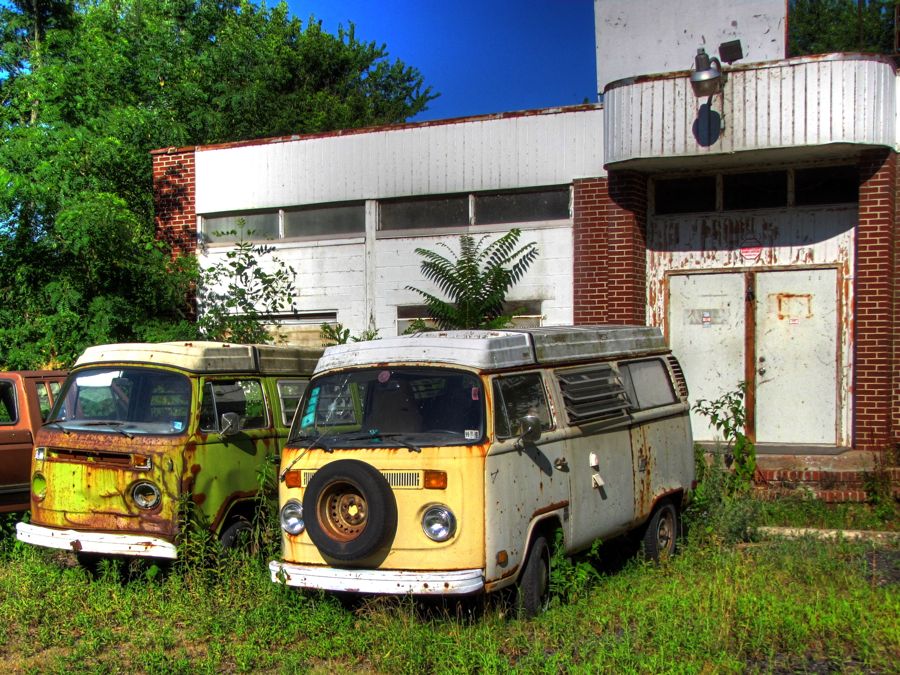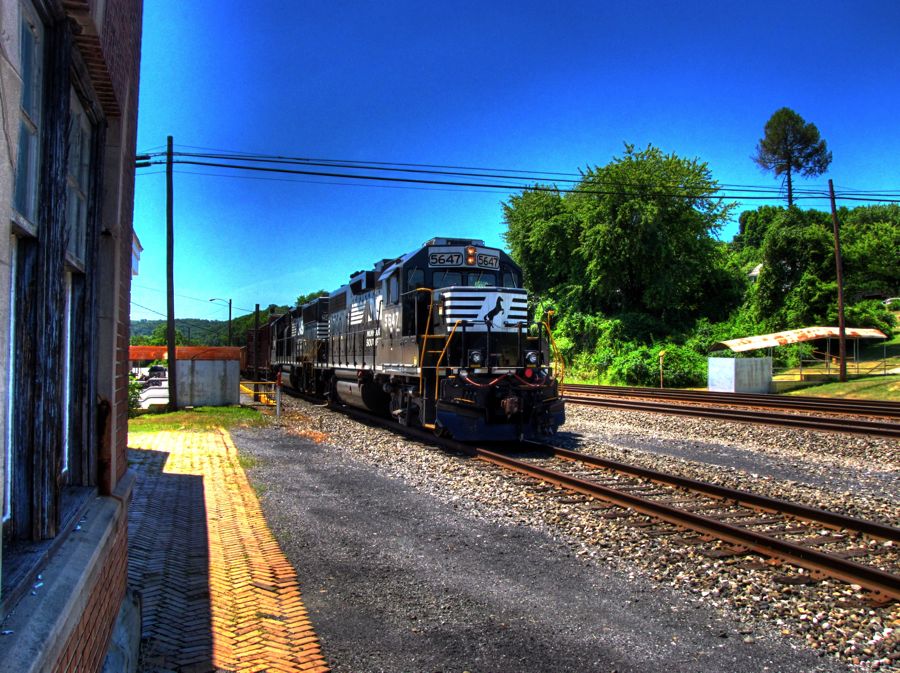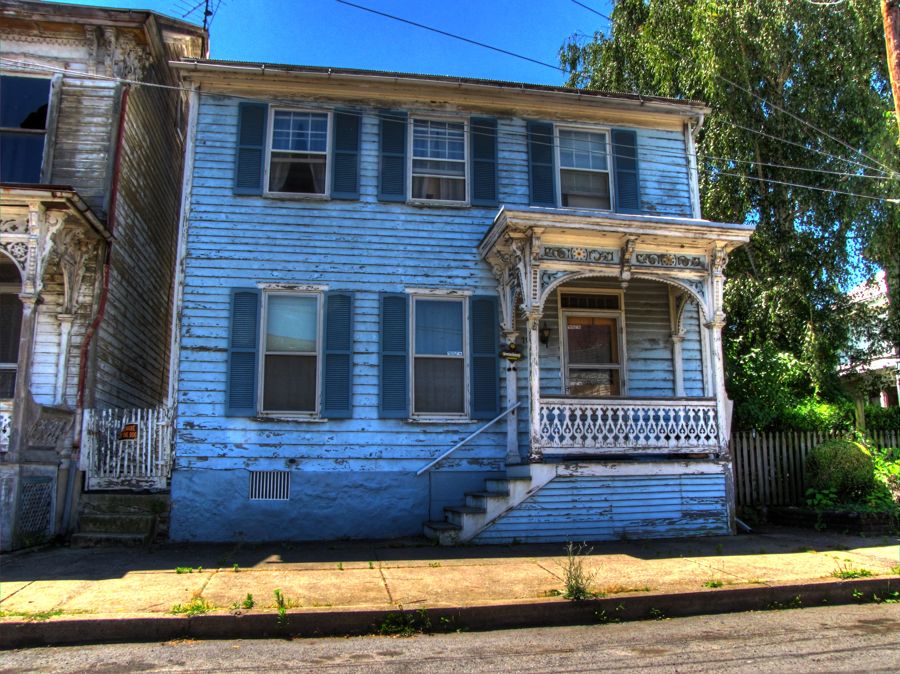From time to time, my motorcycle and car trips have taken me to spots along the Juniata River in Pennsylvania, and I'd always found it to be scenic and inviting. On Saturday, July 3, I decided it might be fun to try to follow the river as closely as possible for as long as possible. I learned that it's a placid, slow-moving river that is a favorite for lazy canoe, inner-tube, or raft trips on hot summer days—as this one was. And it's beautiful.
The Official Trip started in Duncannon, PA, where the Juniata River empties into the Susquehanna River. The old train station was in good shape, although the trains no longer stop here.

Here's the mouth of the Juniata, with the Susquehanna in the distance.

Did I mention the "placid" and "beautiful" part yet?

On any trip such as this, one naturally encounters unexpected places and sights. In this instance, I had stumbled across the previously undiscovered Westfalia Burial Ground, known only to a few local priests and, of course, the dying Westfalia themselves… (In fairness, I love these campers. During my racing years, I frequently camped in one together with my crew chief, Phil Sibert, and his wife Hope. They're models of efficiency. The VW Bus campers that is, although Phil and Hope are also quite good in that respect!)

My route occasionally led me onto short stretches of dirt roads, which were not a problem for the trusty Z4. But it's not every day that you see a sign like this:

The western/southern bank of the Juniata is not overly developed—in fact, much of it is untouched. From time to time, however, there would be signs of civilization such as this vintage cruiser.

At other times, pleasant little towns would appear. Newport, PA was one such, with terrific old houses and signs of former industry.


Thompsontown was another and featured the St. Stephens Episcopal Church from 1825 (the oldest church in Juniata County, in case you were wondering).

Thompsontown also had its share of beautiful old homes, although this one seems to be taking a back seat to someone's sports car…

Before long, it was back to the quiet splendor of an untouched river.

Which is not to say that there never was any civilization along these banks. If you look carefully in this picture, you'll see what looks like a structure back in the woods a little ways. A short hike and a clamber through a ditch later, it proved indeed to be the burned-out shell of someone's house. Sad.


Outside of Port Royal, I realized that I was in Amish country. The signs? First, an abandoned one-room schoolhouse…

Second, lots of laundry drying on clotheslines, dominated by plain color men's pants and somewhat brighter women's dresses…

And last, the frequent hitching posts, complete with sturdy horses. In fairness, I also went by a number of buggies and wagons, and the Amish families always waved back. Much more reliable in this regard than passing motorcyclists!

Port Royal was probably my favorite small town on this trip. On this Saturday, the entire town was one huge yard sale, with all the town's people out in force and numerous visitors. I stopped at the largest community yard sale site and bought some excellent fried chicken from "Uncle Dave," an Amish farmer, and his sisters. They also offered Pennsylvania Dutch Birch Beer, which hit the spot on this exceedingly hot day.
Port Royal's bridge over the Juniata was scenic. Note the wooden steps on the tree in the foreground—it looked to be a perfect spot for climbing out over the river and jumping in. On this day, however, everyone was at the yard sale.

The town's train station appeared to feature a Ferrari-powered train, as suggested by the prancing-horse symbol on the grill of the locomotive.

There were numerous interesting old houses, in varying states of repair.

It turned out that Port Royal is a popular put-in spot for canoe-rental companies. A number of folks are just getting underway in this picture, with help from the rental company staff. Note the couple in the green canoe in the right foreground: they've already run up on some rocks, a good 60 seconds into the trip! Fortunately, they were having fun.

Another family begins their journey, as does an an apparent motorcyclist in the foreground.

Meanwhile, farther up-river, all was quiet. Anyone know what the purple plants were?

From time to time, water-folk would appear on the river, and all of them appeared to be enjoying the day immensely. Some preferred to be in a group, including this enthusiastic bunch, who may have been oblivious to the fact that their raft was in the process of sinking!

Others preferred to float along in solitude. Given the 95-degree heat, I was envious of all of them.

As best I could tell, there was no racetrack anywhere near Racetrack Road. Nearby, however, was this fortress. I assumed it had been an armory, VFW building, or something similar originally, but now it was clearly being used as a home. (Note the basketball hoop and clothes drying in the back.)

I made a side trip across the Juniata to McVeytown, which proved to have stately churches…

…an imposing Freemason Lodge (still in active use)…

…and decorative old houses. Yet another place worthy of a walking tour some day.

Meanwhile, back at the Juniata River, all remained peaceful and inviting.

Nuts! You'd think I would have been smart enough to park in the
shade on a day like this!

There were lots of rolled-up haybales dotting the countryside. Although many were just sitting in fields, apparently it's a good idea to keep them from getting too wet. This fastidious farmer arranged cover for his haybales…

…wherever he could find it! (I wonder what the living room looked like…)

Sometimes, while looking for one thing, you find something else entirely. On the outskirts of Huntingdon, PA, I was looking for Standing Stone Creek. It was easy to locate, but I hadn't expected to encounter an abandoned, ivy-clad stone bridge over the creek. (Actually, there were two of them; one was for cars and the other for trains. Neither had seen any use in a very long time.)

Here is Standing Stone Creek, feeding into the Juniata River. Why the particular interest in this spot? Well, there had been an Onojutta-Haga (Juniata) Indian council ground at this site, hundreds of years ago, and an Indian village called Standing Stone. The name refers to a 14-foot high stone pillar, about 6 inches square, that used to mark the center of the council grounds and was etched with petroglyphs, said to record the history of the village. The stone is believed to have served as a trail guidepost or navigational marker. The Indians reportedly took it with them in 1754 when they left the area (having been bought out by European settlers). It has never been found.

Oh, did I mention that "Juniata" comes from the Iriquoian word "Onojutta," which means "people of the standing stone"?
Fort Standing Stone later stood at this same site to protect against Indian attacks. It's long gone, but upstream on the banks of Standing Stone Creek I found the Epiphany of Our Lord Orthodox Church.

The Juniata River is formed near Huntingdon by the confluence of the Little Juniata and the Raystown Branch, so I had arrived at the end of my by-the-Juniata trip. While I was here, however, I thought I'd take a quick look at Juniata College. On my way there, I went by this "barn-find" project. Any idea what it is? I don't know my panel trucks very well.

The college was scenic but empty, the students having long since traveled home for the summer.

I headed off for home, via Everett, PA and assorted back roads before giving in and slabbing it back to Catonsville on I-70. Along the way, I had to stop for the occasional farm vista…

…the occasional motorboat lawn ornament, complete with tree growing through the hull…

…the occasional wonderful old abandoned farmhouse…

…and the occasional covered bridge (this one being the Halls Mill Bridge, which I'd encountered once before).

At a total length of about 375 hot, sweltering, but visually spectacular miles, it was a great trip. In many places, the roads twisted and turned up and over mountains, providing driving pleasure to go along with the history and beauty of the area.
And the next time I tour the Juniata, I'm going to do it in a canoe (or non-sinking raft).
Rick F.